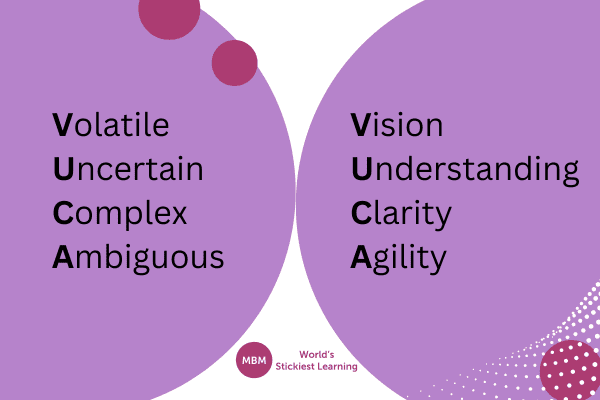What is VUCA in Today’s World?
In the last 20 years, the corporate landscape has changed beyond recognition compared to the previous 20 years. We live in a non-linear world where leaders must look around corners and anticipate the future. The global financial crisis in 2008, Brexit, COVID-19, the regional conflicts around the world and the cost-of-living crisis are all VUCA events. They point towards a more uncertain social, political, and economic corporate climate as we move forward.
The types of events outlined above and the current time environment are what we term VUCA. VUCA stands for Volatile, Uncertain, Complex, Ambiguous. It is an acronym coined by the US Army College in the late 1980s. They grappled with a new reality as the Berlin Wall came down and communism in Europe came to an end. And they were looking to understand what type of world they would be operating in as the 21st century approached.
Nowadays, the concept of VUCA is now deeply embedded into corporate life. This can be overwhelming to absorb and manage. Furthermore, the very nature of what we are experiencing today will only accelerate in pace and complexity in the coming years.
How the Amazon Effect is a Classic VUCA Example

Several years ago a report by Credit Swiss predicted that 20% to 25% of shopping centres will close during this decade. I agree from living in London and walking up any typical high street in the capital. I am struck by the number of charity shops and cafes that have replaced more traditional shops. This decimation of retail is in part what we call, The Amazon Effect.
In the US, we see fewer local boutiques. They are replaced by corporate organisations that can manage locals with high foot traffic. The Everything War (referenced below) is a book outlining Amazon’s ruthless quest to own the world and remake corporate power. The book, scheduled for release in April 2024, exposes Amazon’s impact and influence on the retail sector, which shows no sign of slowing down.
Congress in the US is keeping an eye on a lawsuit brought by the Federal Trade Commission (FTC), which aims to break the giant into separate entities. They are working on the principle that much of Amazon’s power stems from its domination of numerous connected sectors.
For its part, Amazon argues that it constantly works to benefit consumers. The focus of the FTC case is its anti-competitive market operations. It is a case of watching this space as Amazon is not too big to fail. In the eyes of lawmakers, they may be too big to continue with its current structure.

Continuous Disruption and VUCA Are Here to Stay
Netflix, which started out as a DVD rental player, has not only revolutionised the way we watch TV. But also how we spend disposable time. Netflix saw off Blockbusters at a time when it was far and away the market leader and seemingly untouchable. The impact of Netflix is also putting the current BBC’s business model under extreme pressure as well as the license fee being continually scrutinised. In part, we see the younger generations question whether they should pay a license fee for a service they barely use, if at all.
Peak viewing for Netflix may well have come during the various lockdowns. They too face unrealistic expectations for continued growth from Wall Street investors, along with significant competition from Amazon Prime to mention one. The reality is that if a company has no competition, it has no market to operate in. Many times, you may be first to the beachhead. But soon others will follow. Thus, the critical component in this type of disruption is knowing when to stick, twist and pivot.
An article by McKinsey in 2021, identifies the UK moved further in adopting online shopping than any of its Western neighbours. Approximately 20% of UK consumers shop entirely or mostly online. No doubt in 2024 post-COVID-19, that number has continued to climb.
In his groundbreaking book, The Innovators Dilemma, the late Clayton Christensen a Harvard Professor points out, that either you disrupt or you get disrupted. By 2030 with a continued downward pressure of declining margins in many sectors, technology and automation will impact one-third of all tasks in multiple industries.
A Brave New VUCA World

In our era, companies like Uber redefine transportation services, operating without owning any vehicles. On a recent trip to Ireland, a taxi driver told me that Uber has changed his industry beyond recognition. This is despite Uber being heavily regulated in the country.
Airbnb is another example of the shifting times we live in. The home-sharing platform is now bigger than the five biggest Hotel groups combined. Specifically, the Marriott International, Hilton Worldwide, Intercontinental Hotel Group, Wyndham Worldwide and Accor Hotel Group. Their combined listings are 3.9m between them while AirBnB have over 7 million listings.
Again, we see that Airbnb doesn’t own a single hotel room. Yet through technological advances, the disruption to the industry is clear and felt by traditional players in the marketplace. This is something that was unimaginable a few short years ago. Both Uber and Airbnb’s entry into the marketplace demonstrates the impact VUCA-type disruptions can have on a relatively settled industry beforehand.
Sticky Learning ® is 7 times more effective than 1-day training courses. Plus, you will get a Chain of Evidence proving your Return on Investment. Discover soft skills training that changes behaviours long term.

AI and the Future Direction of Travel
I was speaking recently to an L&D expert in the US. He shared how his training company is using AI to support global clients. They localised a message for dispersed, multicultural teams. They created a video in English with a message from the CEO on the topic of corporate values.
By using AI, they were able to translate the video into multiple languages for the workforce to view. Consequently, the videos showed the CEO speaking Korean. The Korean workforce was amazed because they knew their American CEO did not speak their language. The training company using AI (still in its infancy) was able to reach the local workforce and the impact was overwhelmingly both powerful and positive.
This is a unique way of how a global company can localise a message through the medium of AI. Since the advent of globalisation, many companies have wrestled with the global-local dilemma, especially in the late 20th century. As AI becomes even more sophisticated this will lead to a seismic shift for global companies and the workforce in the coming years. It highlights the VUCA environment which we experience daily.
Today is the Slowest It is Going to Be

The speed of continuous unrelenting change is here to stay and today is the slowest it is going to be. Many leaders and team members I speak with face pressure to accomplish more with fewer resources. They have the task of hitting moving targets and being innovative. They state, ‘many times we are running to stand still – planning ahead seems futile.
It’s getting harder as a leader to make confident decisions about future direction based on understanding the ‘bigger picture’. The statements above are classic VUCA. By this, the picture is not only extremely foggy but full of contradictions.
Burnout and mental health-related absenteeism are only going one way at the present time. HR and the business are looking to counter this with well-being programmes responsive to the current environment. All in all, it is an uphill battle.
Post Pandemic Shift
One of the key changes for organisations to deal with post-pandemic is the tug-of-war-like tension between organisations and employees in terms of returning to the office. Many organisations have taken a laissez-faire type approach. Typically, we see trust being high and productivity has not fallen. Therefore they see this flexibility as an advantage when attracting and retaining key talent.
While the argument can be industry-specific, many service organisations have taken another approach by insisting the workforce returns to the office. These organisations are making the case that people need to engage face-to-face. To recreate an informal learning environment and the water cooler chats.
Sometimes the interactions before or after the meetings can be more informative than the actual meetings we all attend. In the final analysis, corporate culture, the sector and how companies manage talent ultimately decide what side they fall on. There is possibly no right answer per se. Just what is appropriate for the culture and business concerned.
The Known-knowns, the Known-unknowns, and the Unknown-unknowns

The late Donald Rumsfeld (Former US Secretary of Defence) made famous the above phrases at a press conference in 2002. He went on to explain there are known knowns, things we know we know. There are also known unknowns, which is to say there are things we know we don’t know. Then there are unknown unknowns, which is to say there are the ones we don’t know, we don’t know.
This last one is VUCA-like in its impact. Meaning, we are unaware of them, so we don’t consider them. Yet we must be able to look around corners to navigate the future. As a leader, decision-making, risk management and planning are key (less so the plan) as that is subject to change in a VUCA world.
A Real-life Example of VUCA
This was during the pandemic with a CEO in the hospitality sector. He met with his CFO and Director of Operations regarding the latest restrictions of the day and how to respond. The CEO opened the meeting by asking, “Where are we currently at?” The director of operations indicated that we were on draft 67 of the plan, a staggering number of drafts and rewrites.
At this point, the CEO had a moment of truth and said, “Close your laptops and forget it. We are talking this through today, based on what we know and what we don’t know and what we think may happen tomorrow.”
An Organisational Response

The antidote to VUCA (Volatile, Uncertain, Complex, Ambiguous) is Vision, Understanding, Clarity and Agility. In the face of volatility, organisations can create a clear vision that creates purpose, and engagement and offers a way forward to all stakeholders. The shift from uncertainty to understanding should offer a roadmap to navigate the unpredictability that abounds today. As we strive to move from complexity to clarity companies must look to simplify at every opportunity.
We should not entertain the temptation to be too clever; simplicity should not be underestimated. Dealing with complexity is the norm, as ambiguity pushes us to consider multiple opinions or positions simultaneously more than ever. The responses require us to develop agility to build into the DNA of the organisation and the workforce. Creating and developing a workforce that embraces innovation is key. A fail-fast mentality will offer a better route to survival and allow a platform for long-term success.
How We Can Manage VUCA
Deloitte Human Capital Trends 2023 study revealed that only 23% of organisations believe their leaders possess effective leadership skills for a disrupted VUCA-like world. Therefore when a leader evaluates the current landscape, they need to become more realistic and aware of the trials and tests that lie ahead. Leaders are responsible for acknowledging the inherent challenges in front of the organisation and the team while ensuring they bring the team with them on the journey.
Respond Effectively
Being open and transparent is now more important than ever. So how can leaders manage VUCA and respond effectively? Leaders can foster a culture of flexibility and encourage a collective mindset where change is expected and embraced. Agile teams can quickly pivot in response to new challenges, making them better equipped to handle volatility and uncertainty. Build into the DNA of the corporate culture deep psychological safety where mistakes and errors allow the team to, look, learn and pivot and rapidly move forward.
Organisations and teams are made up of many different skill sets, experiences and personalities. Hence, the leader must develop his/her own emotional intelligence competency. This means, firstly to manage themselves more effectively, then manage and lead others. In some respects, it is harder to lead now than at any other time in corporate history. However the same applies to employees given the current circumstances.
Many times, there is not a mutual appreciation of this from all stakeholders involved. The need for shared outcomes and collective benefits of pulling in the same direction is not always easy to acknowledge in this environment. When they are not it creates silos and fiefdoms, which keeps the company too internally focussed and this means they take their eyes off of the ball externally.
During uncertainty, it is easy to focus solely on the turbulence. It is critical to understand the fears while engaging and coaching. The team are now a more important part of the leader’s tool kit. What we can say with some degree of certainty is that companies that differentiate themselves in an ever-changing landscape and establish an innovation roadmap have the best chance at growth.
Action Steps

What steps can we take to ensure we stay relevant and add value despite the chaotic nature of what we face every day? The level of day-to-day security we were used to no longer exists. The following will help create a degree of what we can control, manage, and influence and indeed what we may need to let go of.
Tip #1
Being collaborative, agile and consultative is vital to delivering successful outcomes. People who adapt will thrive and those that don’t will fall by the wayside. Teams within organisations undergo the same changes.
Tip #2
Control the controllable. The level of security we expect now may simply not be available. If we take a step back for a moment and ask ourselves, how can we not only survive but thrive in this brittle but very real environment? If we are honest with ourselves, there are many things we can’t control, and many of them external. There are however many things we can control internally. For instance, our attitude, learning, our career path, what we decide to bring to the table are all within our own remit.
Tip #3
Build resilience. Building resilience is key to any type of success in the future. To build resilience and move forward we need to embrace and enjoy reinventing ourselves in the face of an ever-changing world. It is critical to bring purpose to our lives and have a set of stabilising values in an uncertain world. None of the above is easy, but it is critical and worthwhile as we look to secure our place in an ever more uncertain world, as today is the slowest it is going to be.
References
- The Everything War by Dana Mattioli | Waterstones
- Netflix vs Blockbuster – The Official Case Study (drift.com)
How technology is disrupting the UK retail industry | McKinsey - The Innovator’s Dilemma: When New Technologies Cause Great Firms to Fail – Book – Faculty & Research – Harvard Business School (hbs.edu)
- 2023 Global human capital trends | Deloitte Insights




